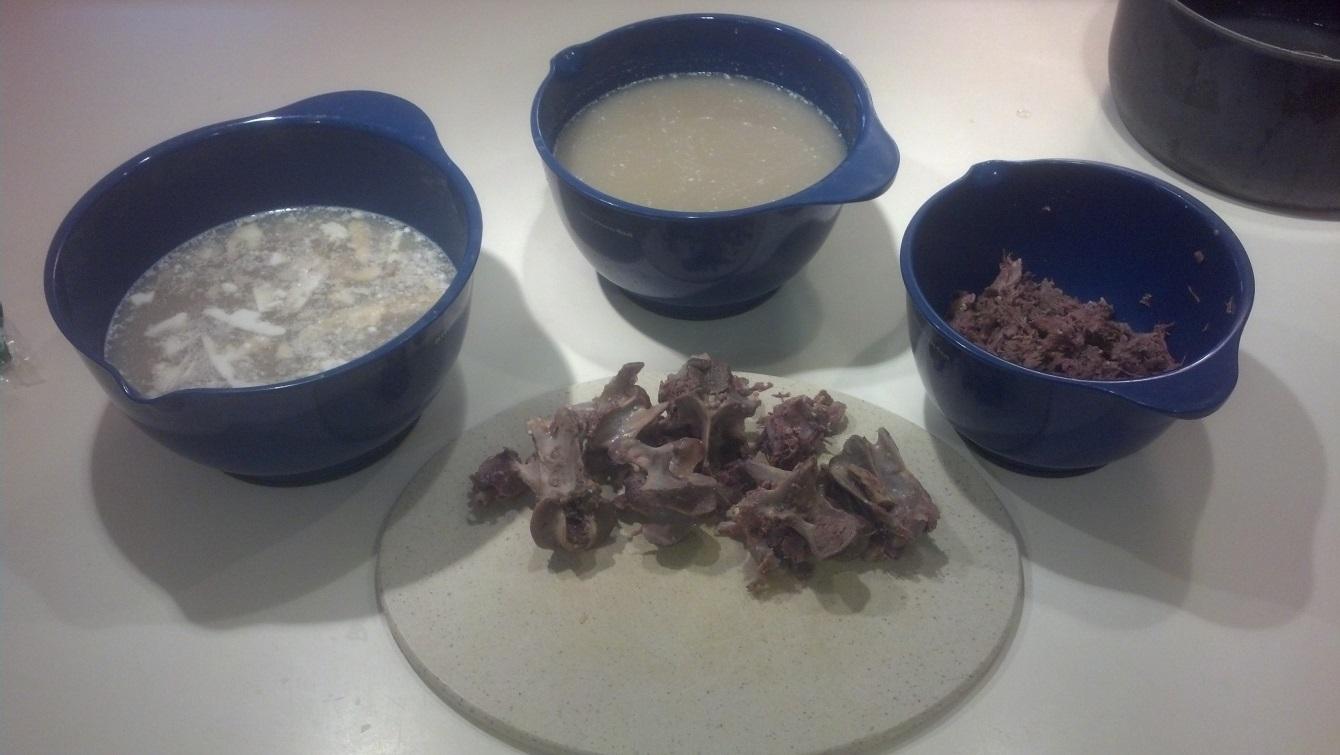RSS/Feed
Home
Staff
Schedule
Location
Courses
Links
Gallery
Gear
Application
Bush Craft & Wilderness Survival Articles, Gear Reviews & Videos |
|||
Using the Neck of the Deer
by Rachel Mifsud
Earlier this fall I traded a bit of my foraged produce for a few cuts of venison. One of the pieces I brought home was the neck, consisting of 6 vertebrae and the meat around them. This usually isn't a prized part of the deer. Lots of people donít even use it. Why? Think of a deer in the forest. What does it do? Bend the neck down, take a bite, lift the head, look forward, look left, look right, repeat... Muscles that are used a lot are high in collagen, a tough connective tissue. This collagen acts like ropes, giving the muscle strength. But it also makes the meat tough and stringy. The neck is arguably the most used part of the deer's body, so it is very high in collagen. And it can be very tough if not cooked properly. But long, slow simmering will dissolve the collagen and the meat will become tender. But the meat is only part of what you can get from this piece. The cavity surrounding the spinal cord and the marrow in the vertebrae are full of fats. These fats and the proteins from the collagen will make excellent broths. With this one, often discarded piece of venison, several dishes can be made.

First, add the whole thing to a pot of water and simmer it for several hours. When the bones can easily be pulled apart and the meat removed without effort, put the whole pot in the refrigerator overnight to allow the fats to congeal on the surface of the broth. The next day, separate the contents of the simmer pot into the meat, the broth, and the bones.

Bean and Rice Soup
4 oz wild rice
1 lb dried beans
4 cups chopped vegetables
4 cups blanched leafy greens
Spice bag
In this recipe, the lean venison broth will add a rich flavor to an otherwise vegetarian dish. The resulting soup is very high in fiber and protein, low in fat, and dense with vitamins and minerals. It is also tasty and quite filling, but not heavy.
Soak about 1/4 lb of wild rice and 1 lb of dry beans overnight. Then drain and put them in crock pot or soup pot. Add about 4 cups of chopped vegetables and 4 cups of blanched leafy greens. Skim the fat solids from the top of the broth, then pour the lean broth into your soup until it is about 1/2 inch deeper than the contents of the pot. Add a spice bag and simmer 4-6 hours. This soup holds up well to freezing in single serve containers.

Wild Mushroom Couscous
1 cup couscous
8 oz dried wild mushrooms
1 cup milk
6 cups broth, keep the fat solids in
1/4 cup dried nettles
The fat that solidifies on top of the venison broth can be used to add flavor in low-fat dishes. In this dish, it enhances the mushrooms, creating a rich, full flavor. The mushrooms, couscous, and broth together create a high protein dish that makes an excellent main course.
Combine all of the ingredients and simmer until the liquid has been absorbed.

Shepherd's Pie and Pasties
2 cups venison meat
4 cups vegetables
1/4 cup broth
2 Tbsp flour
Pie crust for 2 pies
Mashed potatoes
Shepherd's Pie is an easy comfort food. And making pasties at the same time gives you something to put away for later. Preheat the oven to 350 degrees and prep the pie crust. Use 1/2 of the crust in a pie pan. Cut the other 1/2 into 4 squares. Mix the meat, vegetables, broth and flour. Place about 1/2 cup of mixture on each of your squares, fold, seal, and place on a cookie sheet. Put the remaining mixture into the pie shell and spread the mashed potatoes over the top. Bake the pie and the pasties about 1 hour until golden.


Also see related book: Gut It. Cut It. Cook It.: The Deer Hunter's Guide to Processing & Preparing Venison
|
|
Do you have your own tip to share?
Send an email to georgehedgepeth(at)hotmail(dot)com
Briar Patch Outdoors
219 Holmes Street
Durand MI 48429
(989) 288-0168
Learn about backwoods-living, pioneer skills, survival, subsistence hunting, historical trekking, living history, experimental archeology, period living skills, wilderness survival skills, Primitive Survival Skills, Stone Age Technology, Workshops and Classes, Anthropology, Archeology, Artifact Replication,
stone age, stone-age skills, earth skills, native technology, ancient skills, wilderness survival training, outdoors, hide tanning, braintan, brain tanning, nature, awareness, tracking,
medicinal plants, edible plants, prehistoric skills, cordage, fire by friction, kayaking, atlatl making and throwing, arrow, bow, flintknapping, dart, baskets, stone tools, aboriginal skills, traditional, workshops, classes, old ways,
Country Living, Voluntary Simplicity, Simple Living, Homesteading, survival product reviews, back to basics, alternative medicine, wild foraging.